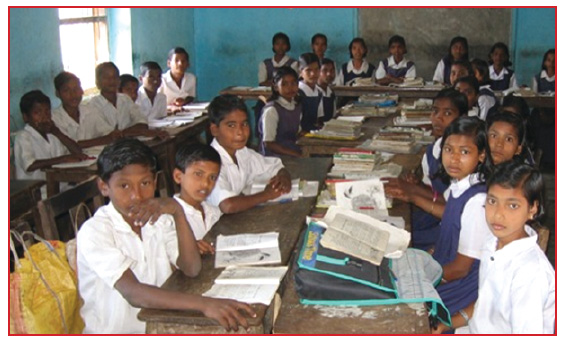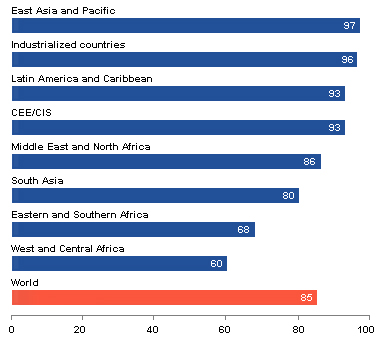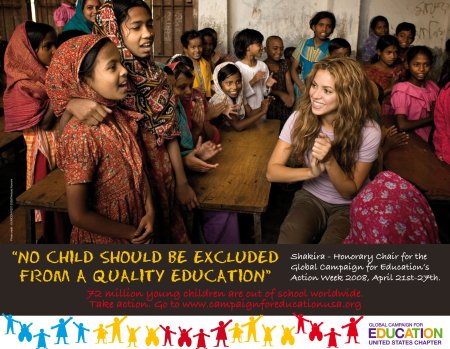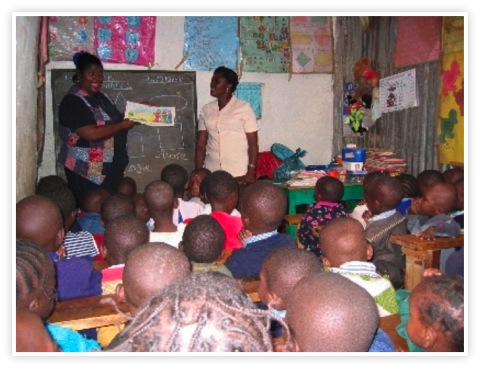User:Vtaylor/CIS2/Summer 2009/Group 1
| Students @ Work - a student collaborative writing project. Help us by providing feedback on the Discussion page. |
CIS 2 Computers and the Internet in Society SUMMER 2009 Final Projects
For project communication, draft document sharing, revision, final submission preparation and publication, we will be using space in the public WikiEducator wiki.
Contents
Goal 2: Achieve Universal Primary Education
The Millennium Development Goals (MDGs) are eight goals to be achieved by 2015 that respond to the world's main development challenges. We will focus on Goal 2: Achieve universal primary education, which has a huge impact on our society. Receiving primary education is a basic right that all children should be given. It can ensure that these individuals make informed decisions and can make better lives for themselves. Universal education will bring all children closer to equality, and increase the quality of life for people in developing countries. Technology can take an important role in ensuring that all boys and girls complete a full course of primary schooling. In order to achieve this goal, technology can assist in raising $11 billion for this cause and help with eliminating school fees. Furthermore, technology can assist in training teachers, providing textbooks and supplies, and ensuring an overall good quality of primary education.
Today, only 85% of primary school-aged children around the world attend school. This graph illustrates how the percentages of children who attend school vary around different parts of the world (Statistics by area, 2009).
Raising $11 Billion
By 2015, one of the Millennium Development goal is to achieve universal primary education. To do so, the goal of reaching $11 billion is a must. With $11 billion dollars there can be money to eliminate school fees, train teachers, and provide the needs necessary for children around the world to gain an education. Raising the $11 billion is crucial and technology can aid by utilizing celebrities, corporations and individuals seeking to make change in an educationally deprived third world country.
Funding can also be provided through the following means:
Global Fund
The Global Fund for Education is a worldwide effort that is supported by many countries including: the United States, Spain, Netherlands, United Kingdom, as well as Intel's CEO Craig Barrett. The goal is to invest in education in developing countries. Gordon Brown, United Kingdom's Prime Minister, has pledged to contribute with around $12 billion over the next ten years towards global education. The United States is one of the crucial players in this Fund and President Obama is a strong supporter of the Global Fund. The U.S. has pledged to contribute with $2 billion to get closer to highly needed $11 billion.(Bermingham, 2009)
Celebrities Can Help
Celebrities can raise awareness about the goal to achieve universal primary education. They can promote the cause and not only attract other colleagues to do the same but more importantly allure the general public to aid this cause. Celebrities can utilize their images in websites, ads, or any articles that can be massively distributed throughout the internet. A Grammy award-winning artist, Shakira, is shown in the image below attempting to evoke awareness for educational outreach in underdeveloped countries.
Corporations Can Help
Corporations can take a key role in raising the $11 billion given that they can give generous contributions. Corporations have taken many roles and steps in which they can give back to the community. Aside from corporations, major executives of big corporations could also make generous donations.
People Can Help
- Charities
- Donations
- online
- in person
- through first world countries' students and schools
- Fundraisers
- students helping students for a better tomorrow
- concerts
Eliminating School Fees
In underdeveloped countries, school fees prevent children from pursuing education. Most families are financially unstable and therefore unable to pay for fees. Thus, millions of children do not have the opportunity to attend school. Many countries have eliminated school fees like Uganda, Kenya, and many other African Countries and have seen a dramatic increase in student enrollment in school (Global AIDS Alliance,2009). We must follow the footsteps of these countries and eliminate school fees. Since technology is an important part of our lives, we can use it to eliminate school fees.
Through the Use of Computers
We can advocate companies to donate their computers or create charities through which people can donate their unwanted computers. We would ideally want as many computers as possible for each school in order to ensure that each student has a computer to learn at his or her own pace. This would decrease the need for teachers and their costs and eliminate low quality instructions from teachers. Computers provide kids effective learning possibilities.
Through the Use of Volunteering
The underdeveloped countries need assistance in all areas including education. We can become more involved by traveling to underdeveloped countries and advocating that their governments provide more funding for schools where the governments can afford it. Also, by creating websites that can be seen by anyone across the world, and by creating online conferences where we can communicate to other people in the world, we can unite to assist in providing educational aid. We can use technology to reach out to people who can truly make a difference, such as affluent politicians, and make our purpose known globally. Through the use of volunteering we can incorporate the internet to reach the masses for it is the most powerful tool an individual with scarce resources can utilize.
Training Teachers
Many countries have resorted to hiring unqualified teachers in order to provide education to more children. However, research shows that quality education is heavily dependant on quality teachers (Sinyolo, 2008). Therefore, once enough money is raised for universal education, a good portion of it should go towards technology to ensure that teachers are qualified. First, computers and Internet access should be brought to various locations around the world. The computers can be obtained through donations or funds that were raised to reach this goal. Establishing facilities with a few computers is a lot cheaper than actually building teacher training schools. Computers can then be used by those who want to become teachers by watching training videos and attending online courses.
Training Videos
Many people find training videos to be highly effective. For example, user reviews for a sexual harassment video said it was very educational, they could relate to it which enhanced their learning, it was broken down in different sections for easier understanding, it provided good examples, and it was very informative and clear (Training video reviews, 2008). Another advantage of training videos is that they can be re-watched for a better understanding. It is evident that many people prefer learning through training videos than in person. Therefore, good quality teacher training videos can be made in different languages to provide good teacher training. These videos can be watched by anyone at different paces, which would make it more convenient for people to become teachers.
Online Courses
With Internet access at training facilities, individuals who want to become teachers can take courses online. This would decrease the cost of sending people to universities at distant locations, and would also make the process of becoming a teacher more convenient. An example of this online program is the WGU Teachers College, which is designed to produce highly competent teachers (Teacher licensure programs, 2009). An online teaching program is flexible, more affordable, and provides excellent preparation to teach in a classroom. This program should be provided for free or at a low cost in areas where qualified teachers are scarce.
Providing Free Textbooks and Supplies
One step in achieving universal primary education is to reduce costs for students and their households, which can be achieved by providing free textbooks and school supplies. Most impoverished households cannot afford textbooks and school supplies, which can negatively affect the continuation of their children's education. A 1999 experiment showed that students who receive financial assistance to buy textbooks and uniforms had a lower dropout rate compared to another group of students that did not get the same amount of assistance. (Nafula, 2001) When parents cannot afford the supplies, children are “always under pressure.” The frustrations these pupils go through affect their academic performance in that they lose interest in education and inevitably drop out.(Nafula 2001) Without availability of textbooks and supplies, students cannot achieve a proper education. Experts also agree that a lack of textbooks results in poor performance in national examinations.(Nafula 2001)
How Schools Can Help
A portion of the necessary $11 billion to achieve universal primary education needs to be allocated to purchase textbooks and supplies. Although adequate financing is crucial for textbooks, it is not sufficient to increase learning. A book about improving the quality of education says that textbooks must be effectively used for several years. Using materials such as textbooks for several years can eliminate costs so it is important that schools implement adequate conservation and repair practices.(Schiefelbein, Valenzuela, and Wolff, 1994) Schools should teach their students the importance of preserving their books by keeping them in good conditions.
How You and Computers Can Help
Currently there are several ways to help provide free textbooks and supplies for students. One well-known form is to sponsor a child through different organizations. Through organizations, such as World Vision, a person can now sponsor a child in another country to help with the costs of not only their survival but the costs of their education. Technologies like computers have made this even easier to accomplish since many organizations have their own websites.
Aside from sponsoring organizations, there are other ways in which people can help provide textbooks and supplies to students through the help of computers. For example, creating a website where textbooks or supplies can be donated and then sent to any given place would be a grandiose gesture. Schools that often update their versions of textbooks and no longer have use for older versions in good condition can use this website to donate those books. Although the books may not be the most current version, that doesn’t mean that they are not useful. Sometimes the difference between older versions and newer versions of textbooks is very minimal. Others that want to help, but do not have textbooks could also donate supplies or money. A website like this can be continuously updated and run by volunteers with the help of any pro-educational organization.
A Modern Classroom
Textbooks and school supplies can be expensive and technology can help reduce these costs. In many modern classrooms, teachers use a combination of self-learning modules and materials to teach reading, writing and arithmetic. Teachers can gradually move away from single textbooks towards a combination of textbooks, workbooks, library materials, and other means to create their own material with the assistance of computers.(Schiefelbein, Valenzuela, and Wolff, 1994) Currently there are many websites that offer great resources for teachers as well as websites that offer free textbooks in different subjects and levels such as textbooksfree.org. Eventually, schools can make a long-term investment with computers that can reduce the future costs of textbooks, assignment worksheets by providing e-books and online or computer programmed assignments.
Ensuring Good Quality of Education
To ensure quality education, especially in areas of the world that have limited access to resources, teaching students through the use of video technology would be optimal. This minimizes the number of unqualified teachers conveying information to students that they are unfamiliar with themselves. Class lectures can be video taped and sent to these areas to make education cost efficient. This makes the job of less qualified teachers easier as well because they are being constantly updated with the latest discoveries in the world of academia. An example would be of Pluto no longer being a planet (Brit, 2006). Such changes within our view of the world would reach these areas sooner. Video education would also allow people to offer the courses at various hours and re-watch material that is unclear to students.
Feedback
To ensure that the students' learning styles are considered, a video review every few months by the students can allow the educators providing the video education to have feedback. Since studies show that every person's learning style is unique, this can provide educators information about how to continuously improve their programs.
Aspiring Teachers Providing Education
Another way to ensure quality of education would be to send aspiring teachers and aspiring professors from first world countries in their last year of college to areas that are in need of educators. The opportunity would allow aspiring teachers to practice being professionals within the field of education, and they have acquired enough knowledge to effectively teach within their fields by the time the end of their academic endeavors approach. Such opportunities are currently offered in websites like this: SoYouWanna.com However, if the idea became more widely spread, people would be more eager to teach abroad.
Conclusion
The Millennium Development Goals are aimed towards creating a sustainable future for the world. Since our focal point is achieving universal primary education by 2015, we have presented options for funding, ensuring quality education as well ways to train teachers through the use of technology, which can assist in providing sustainable education for the masses. Universal education will be strenuous work and will require the assistance of as many individuals as possible, but the goal is within arm’s reach. Studies have shown a direct link between success and education (ICIS, 2008). Therefore, the right to education should not just be a privilege given to the lucky few but a right given to every child out of the 6.4 billion people that exist within our planet. Thanks to social networking websites such as Youtube, Twitter, Myspace and Facebook, you can contribute by: volunteering, providing resources, donating money and/or books, or just simply spreading the word. You can even adopt classrooms and students' educational paths as indicated in Asia America Initiative. Place your acquired knowledge and education into action and help create more motivated individuals who can inevitably provide for their families, and lead healthy and productive lives with the aid of primary education in the future.
Facebook Outreach Group: United Nation's Millennium Development Goal 2
References
- Sinyolo, Dennis (2008, September, 27). Teacher training project launched. Worlds of Education, Issue 27, Retrieved July 29, 2009 from http://www.ei-ie.org/en/article/show.php?id=102&theme=statusofteachers
- (2009, January). Statistics by Area. Retrieved July 30, 2009, from Childinfo Web site: http://www.childinfo.org/education.html
- (2009). Teacher Licensure Programs. Retrieved July 29, 2009, from Western Governors University Web site: http://www.wgu.edu/education/teacher_certification
- (2008, March 3). Training video reviews. Retrieved July 29, 2009, from Kantola Productions Web site: http://www.kantola.com/testimonial.aspx?PPC=BDCV4
- Brit, Robert Roy (2006, August 24). Pluto demoted: no longer a planet in highly controversial definition. Retrieved August 2, 2009, from Space.com Web site: http://www.space.com/scienceastronomy/060824_planet_definition.html
- (2008). Study links success to education, career guidance and information. Retrieved August 2, 2009, from Idaho Career Information System Web site: http://www.cis.idaho.gov/IdahoCareerInformationSystemCIS/ArticleDirectory/StudyLinksSuccesstoEducation/tabid/1581/Default.aspx
- Nafula, Nancy N. (2001) Achieving Sustainable Universal Primary Education through Debt Relief: The case of Kenya. Retrieved July 30, 2009 from http://website1.wider.unu.edu/conference/conference-2001-2/poster%20papers/Nafula.pdf
- Schiefelbein, Ernesto, Valenzuela, Jorge, Wolff, Ernesto. (1994) Improving the quality of primary education in Latin America and the Caribbean. Retrieved July 29,2009 from http://books.google.com/books?hl=en&lr=&id=muBgq9Z0JTgC&oi=fnd&pg=PR7&dq=universal+primary+education,supplies&ots=YYSn6mL1LG&sig=Xq13yqN841FqeITh8zbNJ__BVBI#v=onepage&q=&f=false
- (2009). Free Basic Education. Retrieved August 2, 2009, from Global Aids Alliance Web site: http://www.globalaidsalliance.org/issues/free_basic_education/
- Masao, N. (2008, October 18). Technology can help to reduce poverty in Africa. Retrieved August 2, 2009, from Nick Masao's Thoughts on Programming and Software Development Web site: http://nickmasao.wordpress.com/2008/10/15/how-technology-can-help-reduce-poverty-in-africa/
- Bennett, F. Technology and world education. Retrieved August 2, 2009, Web site: http://www.cris.com/~faben1/worlded.shtml
- (2008)Shakira Has Class. Retrieved August 2, 2009 from http://www.one.org/international/blog/category/global-campaign-for-education/
- Bermingham, D. (2009, February). We don't need no education? Why the united states should take the lead on global education. Retrieved August 2, 2009, from Center For Global Development Web site: http://www.globalaidsalliance.org/page/-/PDFs/CGD_Global_Education_0209.pdf





